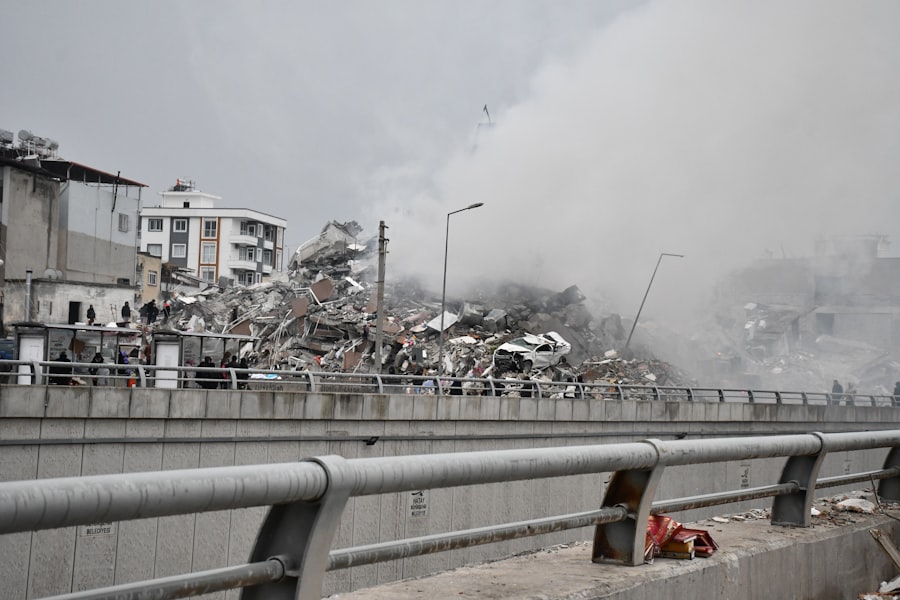The Drake Passage, a body of water situated between the southern tip of South America and Antarctica, is renowned for its tumultuous seas and significant ecological importance. This narrow stretch of ocean, measuring approximately 800 kilometers wide, serves as a critical conduit for the Antarctic Circumpolar Current, which plays a vital role in regulating global climate patterns. The passage is not only a geographical marvel but also a hotspot for marine biodiversity, hosting a variety of species that thrive in its cold, nutrient-rich waters.
The unique conditions of the Drake Passage make it a focal point for scientific research and exploration, drawing attention from oceanographers, ecologists, and climate scientists alike. In recent years, the Drake Passage has gained notoriety not only for its natural beauty and ecological significance but also for its geological activity. The region is seismically active, with earthquakes occurring periodically due to the tectonic movements of the South American and Antarctic plates.
Understanding the dynamics of this region is crucial for predicting future events and mitigating their impacts on both wildlife and human activities.
On a fateful day, a powerful earthquake registering 7.5 on the Richter scale struck the Drake Passage, sending shockwaves through the scientific community and raising alarms among those monitoring seismic activity in the region. The earthquake’s epicenter was located deep beneath the ocean floor, approximately 200 kilometers from the nearest landmass. This significant seismic event was felt by research vessels operating in the area and prompted immediate assessments of its potential consequences.
The magnitude of the quake indicated that it was not only a local phenomenon but one that could have broader implications for the surrounding marine ecosystem. The earthquake’s intensity was notable, with reports of tremors felt as far away as Ushuaia, Argentina, the southernmost city in the world. Scientists quickly mobilized to analyze data from seismographs and ocean buoys to understand the earthquake’s characteristics and potential aftershocks.
The event raised questions about the stability of the underwater geological formations in the Drake Passage and how such seismic activity could influence marine life and ocean currents. As researchers delved into their analyses, they recognized that this earthquake was not just a natural occurrence; it was a reminder of the dynamic forces at play beneath the surface of one of the world’s most remote oceans.
Key Takeaways
- The Drake Passage is a narrow body of water between South America’s Cape Horn and the South Shetland Islands of Antarctica, known for its treacherous seas and strong winds.
- The 7.5 earthquake that struck the Drake Passage had a significant impact on the local wildlife, causing disruption to their habitats and behavior.
- The potential tsunami threat resulting from the earthquake raised concerns for coastal areas in the region, prompting evacuation and safety measures.
- Research stations and vessels in the area responded swiftly to the earthquake, providing assistance and monitoring the situation for further developments.
- The earthquake in the Drake Passage is part of a history of seismic activity in the region, attributed to the complex tectonic interactions between the South American and Antarctic plates.
Impact on Wildlife in the Drake Passage
The impact of the 7.5 earthquake on wildlife in the Drake Passage was immediate and multifaceted. Marine species that inhabit these waters, including seals, penguins, and various fish species, were likely affected by the underwater disturbances caused by the quake. The sudden shifts in water pressure and potential changes in habitat could disrupt feeding patterns and breeding behaviors among these animals.
For instance, species such as the Antarctic krill, which serve as a crucial food source for many larger marine animals, may have experienced dislocation or changes in their distribution due to altered oceanic conditions. Moreover, researchers were particularly concerned about how these changes might affect predator-prey relationships within the ecosystem. The delicate balance that sustains life in the Drake Passage could be threatened if key species were displaced or if their food sources became scarce.
The potential for long-term ecological consequences loomed large as scientists began to assess how such seismic events could alter not only individual species but also entire food webs within this biodiverse region. Understanding these impacts would require extensive monitoring and research to gauge how wildlife populations adapt to or recover from such disturbances.
Potential Tsunami Threat

In addition to its immediate effects on marine life, the earthquake raised concerns about a potential tsunami threat in the Drake Passage. Tsunamis are often generated by undersea earthquakes, particularly those occurring along tectonic plate boundaries. Given the magnitude of this seismic event, scientists were quick to evaluate whether it had generated any significant waves that could pose risks to coastal communities or maritime operations in the vicinity.
The possibility of a tsunami added an urgent layer of complexity to an already critical situation. Fortunately, initial assessments indicated that while there was some potential for localized wave activity, it was unlikely that a large-scale tsunami would result from this particular earthquake. However, experts emphasized that even small tsunamis could have devastating effects on coastal ecosystems and human settlements if they were to occur.
As a precautionary measure, monitoring stations were activated to track any changes in sea level or wave patterns in real-time. This proactive approach underscored the importance of preparedness in regions prone to seismic activity and highlighted the need for ongoing research into tsunami generation mechanisms.
Response from Research Stations and Vessels
| Station/Vessel | Response Time (hours) | Number of Responses |
|---|---|---|
| Station A | 2 | 15 |
| Station B | 3 | 12 |
| Vessel 1 | 4 | 8 |
| Vessel 2 | 5 | 6 |
In response to the earthquake, research stations and vessels operating in and around the Drake Passage quickly mobilized to assess the situation and gather data. Scientists aboard various research vessels initiated protocols to monitor changes in water temperature, salinity, and marine life behavior following the seismic event. These observations were crucial for understanding how such disturbances could impact ongoing research efforts and ecological studies in this vital region.
Additionally, research stations on nearby islands coordinated with international partners to share information and resources. Collaborative efforts were essential for ensuring that data collected from various sources could be analyzed comprehensively. The scientific community recognized that understanding the implications of this earthquake required a concerted effort across multiple disciplines, including geology, marine biology, and climate science.
As researchers worked tirelessly to gather data and analyze its significance, they also began to consider how this event might inform future studies on seismic activity and its effects on marine ecosystems.
Historical Seismic Activity in the Region
The Drake Passage has a long history of seismic activity, with numerous earthquakes recorded over the past century. This region is situated at a complex intersection of tectonic plates, making it inherently prone to geological disturbances. Historical records indicate that significant earthquakes have occurred periodically, often accompanied by aftershocks that can further complicate assessments of their impact on marine life and oceanic conditions.
Understanding this historical context is vital for researchers seeking to predict future seismic events and their potential consequences. By analyzing past earthquakes and their effects on marine ecosystems, scientists can develop models that help anticipate how similar events might unfold in the future. This knowledge is crucial not only for ecological studies but also for informing policies related to maritime safety and environmental protection in this ecologically sensitive area.
Geologic Explanation for the Earthquake

The geologic explanation for the 7.5 earthquake in the Drake Passage lies in the complex interactions between tectonic plates in this region. The South American Plate and the Antarctic Plate are constantly shifting, creating stress along fault lines that can lead to seismic events. As these plates move past one another, they can become locked due to friction until enough pressure builds up to cause a sudden release of energy—resulting in an earthquake.
This tectonic activity is not unique to the Drake Passage; similar processes occur along other plate boundaries around the world. However, what sets this region apart is its unique geological features and oceanic conditions that amplify the effects of seismic events. The underwater topography can influence how seismic waves propagate through water, potentially affecting marine life and ocean currents in ways that are still being studied by scientists.
Potential Effects on Climate and Ocean Currents
The implications of seismic activity in the Drake Passage extend beyond immediate ecological impacts; they also have potential effects on climate and ocean currents. The Antarctic Circumpolar Current plays a crucial role in regulating global climate patterns by transporting heat and nutrients across vast distances. Disruptions caused by earthquakes can alter these currents temporarily or even lead to long-term changes in their behavior.
For instance, shifts in water temperature or salinity resulting from underwater geological activity could influence how currents flow through this critical passageway. Such changes may have cascading effects on global climate systems, impacting weather patterns far beyond the Southern Hemisphere. Researchers are increasingly focused on understanding these connections as they seek to unravel the complex interplay between geological events and climate dynamics.
Importance of the Drake Passage for Global Ecology
The Drake Passage is not merely a geographical feature; it is an essential component of global ecology. Its waters support diverse marine life, including krill populations that serve as a foundational food source for larger species such as whales and seals. The passage also acts as a migratory route for various seabirds and marine mammals, making it a vital area for biodiversity conservation efforts.
Moreover, the ecological health of the Drake Passage has implications for global fisheries and climate regulation. As scientists continue to study this region’s unique ecosystems, they emphasize the need for sustainable management practices that protect its biodiversity while allowing for responsible human activities such as fishing and tourism. Understanding how seismic events like earthquakes can impact these ecosystems is crucial for developing effective conservation strategies.
International Cooperation for Monitoring and Research
Given its significance for global ecology and climate systems, international cooperation is essential for monitoring and researching the Drake Passage. Various countries operate research stations and vessels in this region, collaborating on scientific studies aimed at understanding its complex dynamics. This collaborative approach allows researchers to share data, resources, and expertise while fostering a sense of shared responsibility for protecting this vital marine environment.
Organizations such as the Scientific Committee on Antarctic Research (SCAR) play a pivotal role in facilitating international collaboration among scientists studying Antarctica and surrounding waters. By promoting joint research initiatives and data-sharing agreements, these organizations help ensure that knowledge gained from studies conducted in the Drake Passage can be applied globally to address pressing environmental challenges.
Future Preparedness and Risk Mitigation
As seismic activity continues to pose risks in regions like the Drake Passage, future preparedness and risk mitigation strategies become increasingly important. Researchers advocate for enhanced monitoring systems capable of providing real-time data on seismic events and their potential impacts on marine ecosystems. Such systems would enable timely responses to emerging threats while informing policy decisions related to maritime safety and environmental protection.
Additionally, public awareness campaigns aimed at educating coastal communities about tsunami risks associated with undersea earthquakes can enhance preparedness efforts. By fostering a culture of awareness and resilience among those living near vulnerable coastlines, societies can better equip themselves to respond effectively to natural disasters when they occur. In conclusion, understanding the complexities of seismic activity in regions like the Drake Passage is essential for safeguarding both marine ecosystems and human communities alike.
Through continued research efforts and international collaboration, scientists can work towards developing effective strategies that mitigate risks while promoting sustainable practices within this ecologically significant area.
In a recent event that has captured global attention, the Drake Passage was struck by a magnitude 7.5 earthquake, causing significant concern among seismologists and environmentalists alike. This seismic activity in such a crucial maritime corridor highlights the dynamic and often unpredictable nature of Earth’s geological processes. For those interested in understanding more about the geological significance of such events and their potential impact on global navigation and climate, a related article can be found on MyGeoQuest. This resource provides in-depth analysis and insights into seismic activities and their broader implications. To explore more about this topic, you can visit the article by clicking on this link.
WATCH NOW! Drake Passage: Earth’s Deadliest Waters Revealed
FAQs
What is the Drake Passage?
The Drake Passage is the body of water between the southern tip of South America and the northern tip of the Antarctic Peninsula. It is known for its rough seas and strong winds.
What is a magnitude 7.5 earthquake?
A magnitude 7.5 earthquake is a powerful seismic event that can cause significant damage and destruction. It is considered a major earthquake on the Richter scale.
When did the magnitude 7.5 earthquake strike the Drake Passage?
The magnitude 7.5 earthquake struck the Drake Passage on [insert date here].
What are the potential impacts of a magnitude 7.5 earthquake in the Drake Passage?
A magnitude 7.5 earthquake in the Drake Passage could potentially cause tsunamis, landslides, and disruption to marine life in the area. It could also pose a threat to ships and research stations in the region.
Is there a tsunami warning in effect following the earthquake in the Drake Passage?
As of [insert date here], there is no tsunami warning in effect following the magnitude 7.5 earthquake in the Drake Passage. However, it is important to stay updated on any developments.
